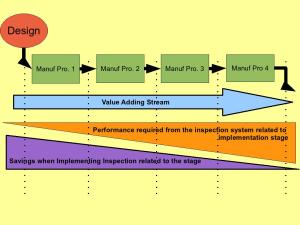Cheap availability of technology.
I read daily about silicon and semiconductor industries. In the actual situation, with a liquidity squeeze, it seems that technological development will soften the rocketing curve that was following and now we see at our backs. Lower demand and less available money for companies to invest in the latest technology have resulted in the closure of the last silicon fab in Silicon Valley and problems for AMD, Quimonda and many others. Regardless of this, we have lived a buoyant period where Moore’s Law was met rigorously.
Advanced n-generation quality control systems have spread in all sectors because of their increasing capabilities, computing power and reduced price. Caliper and gauges are old fashioned tools, where now we have inspection systems checking thousands of features per second in 100% of the production. Behind, SPC tools provide sound and nice charts in real time about production parameters, and the most competitive organizations feed-back this information to take corrective action and maintain quality standards in product specifications.
CMM machines with the most diverse tip materials, vision systems and smart cameras that can provide 3D measurements to be compared directly against CAD models with accuracies of microns, computer software to evaluate deviation, virtual gauges. All this with the formula more (accuracy, speed, precision, repeatability, flexibility) for less (investment, change-over time, calibration) with some additives like connectivity, screening in portable devices, wireless, the list is long.

Check list, an always reliable tool
Resource optimizing strategies
Unfortunately, the availability and acquisition of technology doesn’t guarantees an advantage over competitors. We know how disastrous would be that a non conforming product reaches our customers, that’s why we invest and put effort in inspecting a certain percentage of the production, or even all manufactured parts. Right, no defective product will pass because the available technology permits checking connectivity, metrology, with all sort of non destructive tests. As I explained before, and in other writings, most companies will use inspection data to feed back the production process when the characteristics are getting out of tolerance, changing tools, modifying temperatures, etc. As a good example of CIM practices, data gathered from inspection, influences in real time other manufacturing operations. If the product results to be out of tolerance will be rejected.
In the best case, this part will be a steel casting, a composite or an assembly of a little number of parts. If the inspection results NOT OK, the part can be re-cycled with a low cost or re-worked. If the inspection is carried at the end or even final stages of a complex assembly process, as many parts of different materials are mounted together, as more expensive results fixing the defect. Anyways, it is evident that this non-conforming product didn’t cost nothing to the company. Materials from our low level inventory were dedicated, machines have been used, tools have been worn, electricity, energy, workers wages dedicated to a failed product, and what is more important, we allocated time and resources of our value-adding stream into building a defective part bringing more investment, while a good part would have returned capital.
The question is again how to keep quality levels while reducing costs (very interesting nowadays), and I don’t have the magic recipe, but I know the strategies from a TQM point of view. The strategy is not to ensure the quality level by inspecting against specifications, but to build quality in our product. Even when this seems a stereotye, by ensuring that all produced parts are conforming from the first stages and processes from the value stream, the probability of finding a defective product at the end is highly reduced, but is not my aim to speak here about the benefits of TQM or design for manufacturing, etc.. If only good parts are produced, is there a need for inspection? Yes, but let’s do it the smart way.
Let’s carry inspection in a smart way to improve TQM
If we take for instance a steel part produced in a foundry, inspecting the finished part for measurements is ok, but inspecting the sand cores used for the casting will give better results because you ensure that no defective part will be produced from this source, and all the operations and machining carried in the part from this point are adding value to a good unit. The same applies to many operations in metal forming, presses, punch dies, etc. And inspection must be performed before adding more value in form of grinding, milling or drilling, because those tools and time are too expensive to waste them in a non conforming product. Besides, those tools and inserts can be also inspected by vision systems or other means to ensure they will perform as expected.
When manufacturing electronic products and devices, where assembly involves many digital and electro-mechanical components, quality control after each operation is crucial. In an SMD process, if inspection is carried after reflow, defects like tombstoning and connectivity are easily identified, but reworking the part because the wrong component was picked&placed by the robot or misalignment, would be prohibitively expensive.
As a conclusion, I suggest that inspection is recommended (not necessary) to ensure quality. If we are addressing a manufacturing process from a TQM strategy the efforts should be in the direction of building quality in the product along the process (from design to manufacturing and all the product life-cyle), and not constraining the strategy to implement inspection at the end of a certain operation or at the end of the production lane.
More and more, when inventory reduction and lean implementations are spreading around, we can not permit the utilization of resources to manufacture a bad part that could have been detected before. In addition, we will be able to address the defect source earlier, because it will be easily identified at an early stage, getting rid of blind fire-fighting-guess-where-the-problem-is time consuming activities.

